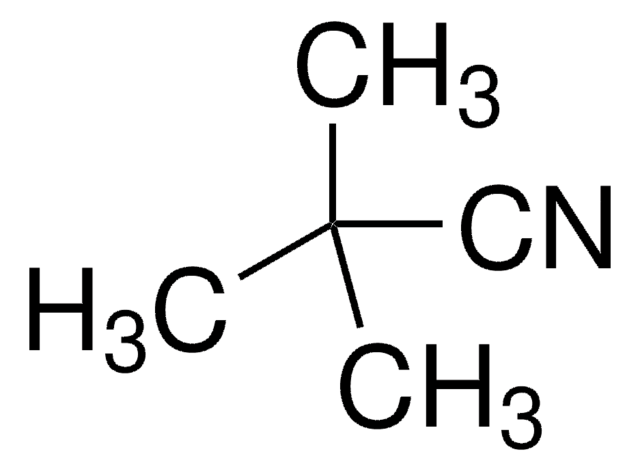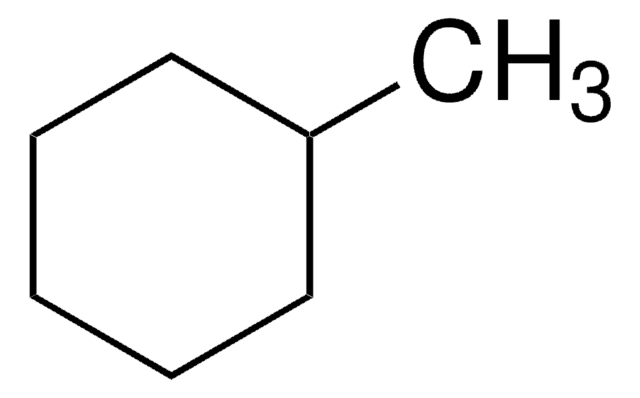81900
Propionitrile
purum, ≥99.0% (GC)
Synonym(s):
PPN, Ethyl cyanide
Sign Into View Organizational & Contract Pricing
Select a Size
All Photos(1)
Select a Size
Change View
About This Item
Linear Formula:
CH3CH2CN
CAS Number:
Molecular Weight:
55.08
Beilstein/REAXYS Number:
773680
EC Number:
MDL number:
UNSPSC Code:
12352100
PubChem Substance ID:
NACRES:
NA.22
Recommended Products
grade
purum
Quality Level
assay
≥99.0% (GC)
form
liquid
refractive index
n20/D 1.366 (lit.)
n20/D 1.366
bp
97 °C (lit.)
mp
−93 °C (lit.)
density
0.772 g/mL at 25 °C (lit.)
functional group
nitrile
SMILES string
CCC#N
Looking for similar products? Visit Product Comparison Guide
Related Categories
Application
- Propionitrile (PPN) is an effective solvent for catalytic asymmetric aldol reaction of a silyl enol ether with aldehydes in the presence of a chiral tin(II) Lewis acid catalyst.
- The co-solvent formed by mixing PPN with acetonitrile can be used to fabricate polymer gel electrolytes (PGEs) of dye-sensitized solar cells (DSSCs), which lead to enhanced stability of gel-state DSSCs.
- PPN can be used as a solvent for the Brønsted acid-catalyzed synthesis of N-alkyl cis-aziridines via [2+1] annulation of a diazo compound formed by the combination of an acetate and enolate. The process does not involve the use of metals or reagents and only atomic nitrogen as a co-product.
signalword
Danger
Hazard Classifications
Acute Tox. 2 Dermal - Acute Tox. 2 Oral - Acute Tox. 4 Inhalation - Eye Irrit. 2 - Flam. Liq. 2
Storage Class
3 - Flammable liquids
wgk_germany
WGK 1
flash_point_f
42.8 °F - closed cup
flash_point_c
6 °C - closed cup
ppe
Eyeshields, Faceshields, Gloves, type ABEK (EN14387) respirator filter
Choose from one of the most recent versions:
Already Own This Product?
Find documentation for the products that you have recently purchased in the Document Library.
Customers Also Viewed
Stability improvement of gel-state dye-sensitized solar cells by utilization the co-solvent effect of propionitrile/acetonitrile and 3-methoxypropionitrile/acetonitrile with poly (acrylonitrile-co-vinyl acetate).
Venkatesan S, et al.
Journal of Power Sources, 274, 506-511 (2015)
The Br?nsted acid-catalyzed direct Aza-Darzens synthesis of N-alkyl cis-aziridines.
Williams A L and Johnston J N
Journal of the American Chemical Society, 126(6), 1612-1613 (2004)
Catalytic asymmetric aldol-type reaction using a chiral tin (II) Lewis acid.
Kobayashi S, et al.
Tetrahedron, 49(9), 1761-1772 (1993)
Sung Hee Joo et al.
Environmental science & technology, 41(4), 1288-1296 (2007-06-28)
The decreasing availability of pristine water supplies is prompting drinking water utilities to exploit waters impacted by wastewater effluents and agricultural runoff. As these waters feature elevated organic nitrogen concentrations, the pathways responsible for transformation of organic nitrogen into toxic
Hayley J Andreazza et al.
Organic & biomolecular chemistry, 4(12), 2466-2472 (2006-06-10)
Franck-Condon one-electron oxidation of the stable anions -CH2CN, CH3-CHCN and -CH2CH2CN (in the collision cell of a reverse-sector mass spectrometer) produce the radicals .CH2CN, CH3.CHCN and .CH2CH2CN, which neither rearrange nor decompose during the microsecond duration of the neutralisation-reionisation experiment.
Our team of scientists has experience in all areas of research including Life Science, Material Science, Chemical Synthesis, Chromatography, Analytical and many others.
Contact Technical Service












